A game programmer is a software engineer, programmer, or computer scientist who primarily develops codebases for video games or related software, such as game development tools. Game programming has many specialized disciplines, all of which fall under the umbrella term of "game programmer". A game programmer should not be confused with a game designer, who works on game design.

Mouse Trap is a maze video game developed by Exidy and released in arcades in 1981. It is similar to Pac-Man, with the main character replaced by a mouse, the dots with cheese, the ghosts with cats, and the energizers with bones. After collecting a bone, pressing a button turns the mouse into a dog for a brief period of time. Color-coded doors in the maze can be toggled by pressing a button of the same color. A hawk periodically flies across the maze, unrestricted by walls.
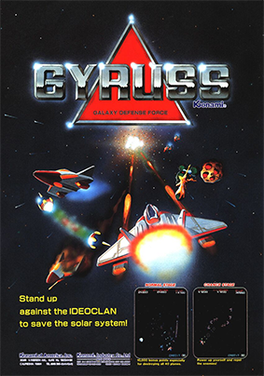
Gyruss is shoot 'em up arcade video game designed by Yoshiki Okamoto and released by Konami in 1983. Gyruss was initially licensed to Centuri in the United States for dedicated machines, before Konami released their own self-distributed conversion kits for the game. Parker Brothers released contemporary ports for home systems. An enhanced version for the Family Computer Disk System was released in 1988, which was released to the North American Nintendo Entertainment System in early 1989.
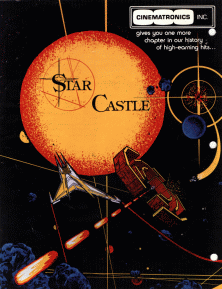
Star Castle is a vector graphics multidirectional shooter released in arcades by Cinematronics in 1980. The game involves obliterating a series of defenses orbiting a stationary turret in the center of the screen. The display is black and white with the colors of the rings and screen provided by a transparent plastic screen overlay.

Stargate is a horizontally scrolling shooter released as an arcade video game in 1981 by Williams Electronics. Created by Eugene Jarvis and Larry DeMar, it is a sequel to Defender which was released earlier in the year. It was the first of only three productions from Vid Kidz, an independent development house formed by Jarvis and DeMar. Some home ports of Stargate were renamed to Defender II for legal reasons.

Ghostbusters is a licensed game by Activision based on the film of the same name. It was designed by David Crane and released for several home computer platforms in 1984, and later for video game console systems, including the Atari 2600, Master System and Nintendo Entertainment System. The primary target was the Commodore 64 and the programmer for the initial version of the game was Adam Bellin. All versions of the game were released in the USA except for the Amstrad CPC and ZX Spectrum versions, which were released only in Europe, and the MSX version, which was released only in Europe, South America, and Japan.

Sunset Riders is a side-scrolling run and gun video game developed and released by Konami as an arcade video game in 1991. It is set in the American Old West, where the player(s) take control of bounty hunters who are seeking the rewards offered for various criminals.

Crossbow is a light gun shooter released as an arcade video game by Exidy in 1983. It was later published by Absolute Entertainment for the Commodore 64 and MS-DOS, and by Atari Corporation for the Atari 2600, Atari 7800, and Atari 8-bit computers starting in 1987. The game is controlled via a positional gun that resembles a full-sized crossbow.

Chiller is a light gun arcade game released in 1986 by Exidy. An unlicensed port was released for the Nintendo Entertainment System in 1990 by American Game Cartridges in the US, and in Australia by HES, with the option of using either the standard controller or the NES Zapper.

In video games, a level is any space available to the player during the course of completion of an objective. Video game levels generally have progressively increasing difficulty to appeal to players with different skill levels. Each level may present new concepts and challenges to keep a player's interest high.

Mine Storm is a multidirectional shooter similar to Atari, Inc.'s 1979 Asteroids arcade game. Designed and programmed by John Hall, it was published in 1982 by General Consumer Electronics as the built-in game for the Vectrex system. Although not provided on a physical cartridge, a Mine Storm screen overlay and manual were included with each system to support the built-in game.
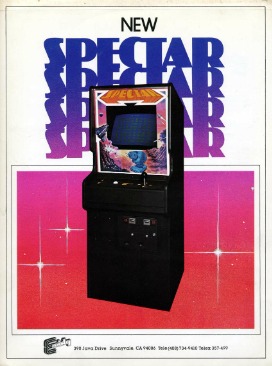
Spectar is a maze shooter released in arcades by Exidy as a sequel to Targ. The game depicts vehicular combat in a future world. The original game was released in November 1980 and a ROM upgrade was released in April 1981.
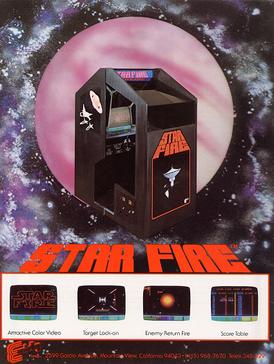
Star Fire is a first-person arcade coin-operated space combat video game created by Technical Magic for Midway-Bally and licensed for manufacture to Exidy in December 1978. It was distributed in Japan by Taito and Esco Trading in 1979. Designed by Caltech engineers Ted Michon, and David Rolfe and inspired by the movie Star Wars, the game is not based on a licensed property.
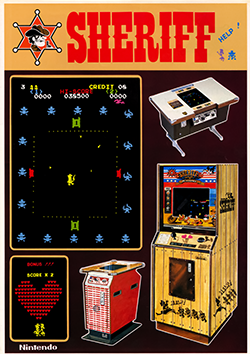
Sheriff, also known as Bandido, is a 1979 multi-directional shooter arcade game by Nintendo. It is one of several Western-themed video games from the 1970s, along with Western Gun, Outlaw, and Boot Hill. The player controls a county sheriff tasked with defense of a town against bandits, to rescue the captured woman. It was a commercial success in Japan, where it was among the top ten highest-grossing arcade games of 1979.

Pirate Ship Higemaru is a maze video game by Capcom originally released in 1984 as a coin-operated arcade game. The gameplay is similar to that of the 1982 Sega arcade game Pengo, but with the arctic theme replaced with that of a pirate ship.
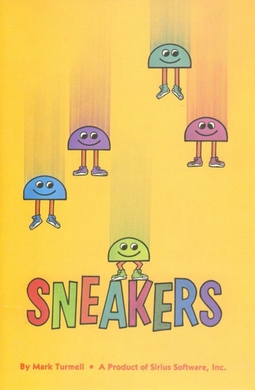
Sneakers is a fixed shooter video game for the Apple II written by Mark Turmell and published by Sirius Software in 1981. A version for Atari 8-bit computers was released the same year. Sneakers was Turmell's first published game. He later was the lead designer and programmer of 1993's NBA Jam.
High Noon is a western-themed shoot 'em up game written for the Commodore 64 and published by Ocean Software in 1984. Originally advertised on both the Commodore 64 and ZX Spectrum, the game itself was only ever released on the Commodore 64.

Circus is a block breaker arcade video game released by Exidy in 1977, and distributed by Taito in Japan. The game is a re-themed variant of Atari, Inc.'s Breakout, where the player controls a seesaw and clown in order to pop all the balloons in the level. The game has been copied and released under different names by numerous other companies in both the United States and Japan.
Let's! TV Play Classic is a series of Japan-only plug & play devices developed and distributed by Bandai programmed on XaviX software created by SSD Company Limited in 2006 that contain arcade games from either Namco or Taito, with Namco's being called "Namco Nostalgia" while Taito's are called "Taito Nostalgia". Each device in the series contains 4 games, with 2 being classic arcade games while the other 2 are new games using the original game's sprites developed by Bandai.

Danger Ranger is a non-scrolling platform game designed by Ken Kalish and published in 1983 by Microdeal for the Dragon 32/64 and TRS-80 Color Computer. The game was ported to the Atari 8-bit computers and Commodore 64 by Rita Jay in 1984.

















